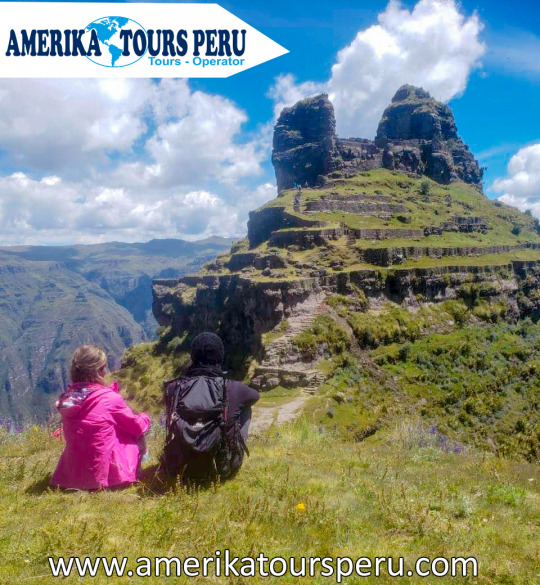In runasimi "waqra" is horn and "pukara" is the equivalent of strength. Seeing the picture the name is more than eloquent. But the shepherds of the communities of Acos, to the south of the city of Cusco, also know him as Llamapukara: “they are not horns - they assure - they are the ears of a flame that is alert to the presence of foreigners”.

Despite its almost impregnable location - at the top of a peak over the chasms that overlook the Apurimac River canyon and over 4 thousand meters above sea level - at least four old roads lead to this fortress.
Undoubtedly, both "ears" or "horns" found in the fortress were cause for sacralization among its builders. The best preserved are its walls, stairs, terraces and finely carved stone rooms in the best classic Inca style.
For archaeologist Miguel Cornejo, Waqrapukara represents the “architecture of power. It is a first-class Inca sanctuary, which denotes immense political and religious power not yet deciphered, ”says Cornejo. “Before entering Waqrapukara, you reach a space formed by river and wind erosion. The whole natural environment warns from afar that a special place, out of the ordinary, of incomparable beauty is being reached, ”adds the PUCP archaeologist.
Waqrapukara is a good adventure and experiential tourism destination. The truth is that this route does not ask for tourists, it requires expeditionaries.
Unlike other destinations with many visitors, you can camp in the surrounding area in Waqrapukara. I recommend enjoying the night sky. You may find the reason why your former builders chose this magical and mysterious place.
How to get?
One of the routes to reach the Waqrapukara fortress is to go to the Pomacanchi district, province of Acomayo, which is approximately 115 km from the city of Cusco.
Arriving at the Chuquicahuana bridge, which is 92 km away, we head down the road to Acomayo. Arriving at the place called Cebadapata, we find the Pomacanchi Lagoon, which is the first tourist attraction, in this lagoon we can observe fishermen in small boats doing their daily work and the natural landscape with all the fauna and flora of the place.
In front of Cebadapata we can find the archaeological remains of K’ero, bastions, pre-Hispanic andenería, colcas and other constructions. In this way we arrive at Pomacanchi, the Ecotourism Capital of the Cusco Region, in this town we will find the house of Carmen Rosa Noguera, mother of the Caudillo José Gabriel Condorcanqui “Tupac Amaru”, who as we know started the Latin American Independence Revolution.
Why do some promote traveling to Waqrapukara through Pomacanchi?
Because we find attractive places, not only for the archeological remains of K'ero, the pre-Inca constructions in Conchacalla, the Pomacanchi Lagoon, the Huaca de K'ullupata, the vicuna reserve of Pumawasi but also for the fauna and flora, we will find species native such as achanqaray, qantu, chillka, t'ankar, ich'u, qeto qeto, panti, totora and other species. In the fauna we will find: Falcon, kestrel, eagle, condors, vicuñas, puma, deer, fox, skunk. The other advantage is that Pomacanchi is a colonial-style villa, as evidenced by its colonial bridges distributed throughout the district, its church also has accommodations for the traveler, such as the Municipal Lodging that has a dining room. On the way to the fortress we can enjoy the abundant wild vegetation of the area, spectacular view of the Apurimac Canyon and many other beauties.
Undoubtedly, both "ears" or "horns" found in the fortress were cause for sacralization among its builders. The best preserved are its walls, stairs, terraces and finely carved stone rooms in the best classic Inca style.
For archaeologist Miguel Cornejo, Waqrapukara represents the “architecture of power. It is a first-class Inca sanctuary, which denotes immense political and religious power not yet deciphered, ”says Cornejo. “Before entering Waqrapukara, you reach a space formed by river and wind erosion. The whole natural environment warns from afar that a special place, out of the ordinary, of incomparable beauty is being reached, ”adds the PUCP archaeologist.
Waqrapukara is a good adventure and experiential tourism destination. The truth is that this route does not ask for tourists, it requires expeditionaries.
Unlike other destinations with many visitors, you can camp in the surrounding area in Waqrapukara. I recommend enjoying the night sky. You may find the reason why your former builders chose this magical and mysterious place.
lunes, 30 de diciembre de 2019
Waqrapukara: discovering its mysteries
13:19
amerika tours peru, amerikatoursperu, cuco, PERU, WAQRAPUCARA, waqrapukara tour, waqrapukaratour
No comments






0 comentarios:
Publicar un comentario